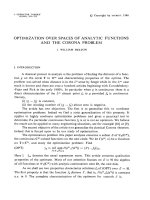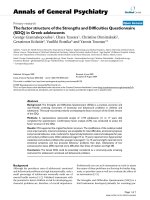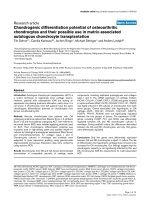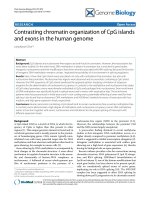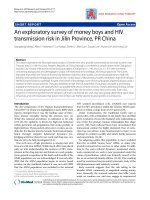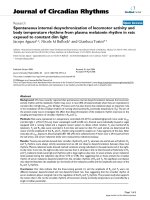Báo cáo y học: "Chinese herbal extracts of Rubia cordifolia and Dianthus superbus suppress IgE production and prevent peanut-induced anaphylaxis" pptx
Bạn đang xem bản rút gọn của tài liệu. Xem và tải ngay bản đầy đủ của tài liệu tại đây (392.9 KB, 33 trang )
This Provisional PDF corresponds to the article as it appeared upon acceptance. Fully formatted
PDF and full text (HTML) versions will be made available soon.
Chinese herbal extracts of Rubia cordifolia and Dianthus superbus suppress IgE
production and prevent peanut-induced anaphylaxis
Chinese Medicine 2011, 6:35 doi:10.1186/1749-8546-6-35
Ivan Lopez Exposito ()
Alexandra Castillo ()
Nan Yang ()
Banghao Liang ()
Xiu-Min Li ()
ISSN 1749-8546
Article type Research
Submission date 1 December 2010
Acceptance date 30 September 2011
Publication date 30 September 2011
Article URL />This peer-reviewed article was published immediately upon acceptance. It can be downloaded,
printed and distributed freely for any purposes (see copyright notice below).
Articles in Chinese Medicine are listed in PubMed and archived at PubMed Central.
For information about publishing your research in Chinese Medicine or any BioMed Central journal,
go to
/>For information about other BioMed Central publications go to
/>Chinese Medicine
© 2011 Lopez Exposito et al. ; licensee BioMed Central Ltd.
This is an open access article distributed under the terms of the Creative Commons Attribution License ( />which permits unrestricted use, distribution, and reproduction in any medium, provided the original work is properly cited.
Chinese herbal extracts of Rubia cordifolia and Dianthus superbus
suppress IgE production and prevent peanut-induced anaphylaxis
Iván López-Expósito, Alexandra Castillo, Nan Yang, Banghao Liang and Xiu-Min Li
*
Department of Pediatrics, Mount Sinai School of Medicine, New York, NY 10029-6574,
USA
*
Corresponding author:
Xiu-Min Li
Department of Pediatrics
Mount Sinai School of Medicine
New York, NY 10029-6574
USA
E-mail addresses:
ILE:
AC:
NY:
XML:
BL:
Abstract
Background Peanut allergy is characterized by increased levels of peanut-specific IgE in
the serum of most patients. Thus, the most logical therapy would be to inhibit the IgE
production by committed B-cells. This study aims to investigate the unreported anti-IgE
effects of Chinese herbal extracts of Rubia cordifolia (Qiancao) and Dianthus superbus
(Qumai). Methods Seventy herbal extracts were tested for their ability to reduce IgE
secretion by a human B-cell line. Those with the lowest inhibitory concentration 50 (IC
50
)
values were tested in a mouse model of peanut-anaphylaxis. Anaphylactic scores, body
temperature, plasma histamine and peanut-specific-immunoglobulins were determined.
Results Rubia cordifolia and Dianthus superbus inhibited the in vitro IgE production by
a human B-cell line in a dose-dependent manner and the in vivo IgE production in a
murine model of peanut allergy without affecting peanut-specific-IgG1 levels. After
challenge, all mice in the sham groups developed anaphylactic reactions and increased
plasma histamine levels. The extract-treated mice demonstrated significantly reduced
peanut-triggered anaphylactic reactions and plasma histamine levels. Conclusion The
extracts of Rubia cordifolia and Dianthus superbus inhibited the IgE production in vivo
and in vitro as well as reduced anaphylactic reactions in peanut-allergic mice, suggesting
potentials for allergy treatments.
Background
Peanut allergy (PNA) is a worldwide health concern, particularly in developed countries.
PNA accounts for approximately 80% of fatal and near-fatal food allergic reactions [1].
The prevalence of childhood PNA in the United States (USA) is currently at 1.4%, up
from 0.8% in 2002 and 0.4% in 1997 [1]. Apart from strict avoidance of the
peanut-containing foods, no satisfactory therapy is available to prevent or reverse this
condition. Standard subcutaneous immunotherapy has been abandoned due to undesirable
adverse reactions and marginal efficacy [2]. While peanut oral immunotherapy (OIT) is a
promising therapeutic intervention for PNA [3], many questions remain, such as the risks
of OIT compared with avoidance, dosing regimen issues, patient selection and post
desensitization strategy [4]. Sublingual immunotherapy (SLIT) is a new method of
treating food allergy, with few systemic reactions; however, only one study [5]
determined the effect of SLIT on PNA. For these reasons, a safe and effective therapy for
peanut allergy is urgently needed.
Research suggests that certain Chinese medicinal herbs may have the potential for
treating allergy and asthma [6]. For the first time, our group developed a food allergy
herbal formula (FAHF2) that blocks peanut-induced anaphylaxis in a mouse model [7;8].
A recent clinical trial demonstrated that the FAHF2 is safe and well-tolerated, with
beneficial immunomodulatory effects in vitro [9].
Similar to other allergies, PNA is characterized by increased levels of peanut-specific IgE
in the serum of most patients. Cross-linking of mast cell/basophil membrane cell-bound
IgE antibodies by allergen results in the release of inflammatory mediators responsible
for the signs and symptoms of PNA [10]. Omalizumab (Xolair) is the only available
anti-IgE therapy which is one of the most logical therapies for PNA. Omalizumab
effectively neutralizes IgE and may even cause apoptosis of committed B-cells by cross
linking membrane IgE. However, relapse is likely if the antibody treatment stops [11, 12].
While investigation of anti-allergic therapies from natural products sources has been
increasing in the past years, the number of studies on reducing IgE production are limited
[13].
The present study aims to investigate Chinese medicinal herbs that have previously
unreported anti-IgE effects. Seventy herbal extracts were tested for their ability to reduce
the IgE secretion by a human myeloma B-cell line. Those with the lowest IC
50
values
were then tested in a mouse model of peanut-anaphylaxis.
Methods
Herbs
All medicinal herbs used in this study were purchased from EFong Herbs Inc. (USA).
These products were made by Gangdong Yifang Pharmaceutical Company Ltd. (China)
and commercially available in the US via EFong Herbs Inc. All herbs were extracted with
water and then concentrated and dried. The manufacturing processes and the product
quality analyses are in accordance with GMP standards [14]. Each powdered extract was
packaged and stored at room temperature under dark and dry conditions.
High performance liquid chromatography (HPLC) fingerprints from Qiancao and
Qumai
HPLC fingerprints are recommended by the United States Food and Drug Administration
as a means of standardization for botanical products. HPLC was carried out as previously
described [9;15;16]. Briefly, 200mg of Qiancao (QC) and Qumai (QM) extracts were
dissolved into 2mL mobile phase mixture consisting of 0.10% formic acid and
acetonitrile (1:1). Each sample solution was filtered through a 0.2µm filter (Whatman
Inc., USA). Each sample (10µL) was analyzed on a Waters Alliance 2695 HPLC system
(Waters Corporation, USA) with a photodiode array detector (2996) (Waters Corporation,
USA). The separation conditions were as follows: Zorbax SB-C
18
column (150×4.6mm;
5µm particle size) from Agilent Technologies (USA); mobile phases: 0.10% formic acid
(A) and acetonitrile (B); flow rate: 1.0mL/min; detection wavelength: 254nm. Linear
separation gradient was from 2% of B to 48 % for 75 minutes. Chromatographic results
were acquired and processed with the Waters’ Empower software (Waters Corporation,
USA). All chemicals and solvents used were of HPLC grade (Fisher Scientific, USA).
HPLC fingerprints of QC and QM are shown in Figure 1.
U266 human B cell cultures and IgE measurement
Human U266B1 multiple myeloma cells (ATCC TIB-196™, American Type Culture
Collection, USA) were cultured at 37°C in 5% CO
2
. RPMI 1640 medium, supplemented
with 10% of fetal bovine serum (FBS), 1mM sodium pyruvate, 1×10
−5
M 2-ME and 0.5%
penicillin-streptomycin, was used as a culture medium. Cells were grown at an initial
concentration of 2×10
5
cells /mL. Initially, all herbal extracts (Table 1) were added at Day
0 at 500µg/mL and 100µg/mL. At Day 6 the supernatants were harvested for total IgE
assay. For those herbs with an IgE inhibition rate higher than 95% at both concentrations
assayed, a dose-inhibition curve was performed.
Total IgE (T-IgE) was examined with a fluorescent enzyme immunoassay (ImmunoCAP
FEIA, Phadia, Germany) and expressed in kU/L. The detection range of T-IgE was
2-2000kU/L. Samples were measured undiluted, while samples with undetectable T-IgE
were assigned an arbitrary value of 1kU/L. The percentage of IgE inhibition was
calculated as 100-[IgE concentration (sample treated) ×100/IgE concentration (sample
untreated)]
Cell viability assays for QC and QM cultures
The viability of control and treated cells was evaluated with the
3-(4,5-dimethylthiazol-2-yl)-2,5-diphenyltetrazolium bromide (MTT) assay in triplicates.
Briefly, cells (2×10
4
) were incubated in 96-well microtiter plate containing 100µL of the
culture medium (RPMI 1640 medium supplemented with 10% FBS, 1mM sodium
pyruvate, 1×10
−5
M 2-ME and 0.5% penicillin-streptomycin) with or without tested
compounds at 0, 3.125, 6.25, 12.5 25, 50, and 100µg/ml). The MTT assay was performed
after six days. Cells in each well were incubated at 37°C in 20µg of the MTT (1mg/mL)
for four hours. After incubation, 150µL of Dimethyl sulfoxide (DMSO) was added to
each well. Absorbance of the mixture at 595nm was determined with a microplate ELISA
reader. The results were derived from three independent experiments.
In vivo experimental protocol
Female C3He/J mice (6 weeks old) were purchased from Jackson Laboratory (USA).
Standard guidelines for the care and use of animals were followed [17]. To generate a
peanut allergy model, we sensitized the mice intraperitoneally (i.p.) each week with
200µg of crude peanut extract (CPE) and 2mg of alum in 0.5mL of phosphate buffered
saline (PBS) for four weeks, and then challenged (i.p.) them with 1000µg CPE in 500µL
PBS two weeks after the last sensitization. To determine whether QC and/or QM prevent
peanut anaphylactic reactions, we administered extracts of QC (2mg) or QM (2mg), or
QC (4mg) or QM (4mg) in 0.5mL of water intragastrically (i.g.) twice daily for five
weeks beginning at Day 0 of the protocol. The dose was determined by a conversion table
of equivalent human to animal dose ratios based on body surface area [18]. Additional
peanut-sensitized mice received 0.5mL water (i.g.) twice daily for five weeks as sham
treatment controls (sham). Naïve mice served as normal controls (Figure 2).
Assessment of systemic anaphylactic signs and measurement of core body temperatures
Anaphylactic signs were evaluated 30 to 40 minutes after the commencement of the
challenge by two investigators using the following scoring: 0, no signs; 1, scratching and
rubbing around the mouth and head; 2, puffiness and redness around the eyes and mouth,
diarrhea, pilar erecti, reduced activity and/or decreased activity with increased respiratory
rate; 3, wheezing, labored respiration and cyanosis around the mouth and tail; 4, no
activity after prodding or tremor and convulsions and 5, death. Rectal temperatures were
measured with a thermal probe (Harvard Apparatus, USA) every 15 minutes during the
30 minutes after the peanut challenge.
Measurement of plasma histamine and mouse mast cell protease-1 (MMCP1) levels
Plasma was obtained 30 minutes after the challenge, histamine and MMCP1 levels were
analyzed with an enzyme immunoassay kit as described by the manufacturers
(Immunotech, France and Moredun Scientific, UK for histamine and MMCP1
measurements respectively).
Measurement of serum antibodies
Retro-orbital venous blood was collected before the challenge. Sera were collected and
stored at -80° C until analysis. Peanut-specific IgE and IgG1 levels were determined with
a monoclonal antibody as previously described [19].
Acute and sub chronic toxicity studies
The lethal dose 50 (LD
50
) protocol was designed as follows. Seven-week old mice were
fed 12 times the highest therapeutic dose used in this experiment and observed for 12 and
24 hours; the LD
50
was then calculated. Mice fed with water served as controls (sham). If
no death occurred 12 and 24 hours after feeding, mice were observed for an additional 14
days. If no death occurred during this observation period, all mice were sacrificed.
Samples were then collected for biochemical analyses, complete blood cell counts (CBC)
and histological analyses. Biochemical analyses of blood urea nitrogen (BUN) as well as
creatinine and alanine aminotransferase (ALT) were performed on a PROCHEM-V
instrumentation (Synbiotics, USA) for the assessment of the kidney and liver functions
respectively. For CBC testing, blood samples (20µL) were collected and subjected to
analysis by Multispecies Hematology Systems (CDC Technologies, USA). These assays
were performed at Mount Sinai School of Medicine, Center for Laboratory Animal
Sciences, where these assays are routinely performed to monitor the health of laboratory
animals. Histological analysis of major organs (ie kidney, liver, heart, spleen, lung,
stomach and intestine) was performed in a blinded manner.
Statistical analysis
One-way or two-way ANOVA (analysis of variance) was performed followed by a
Bonferroni correction for all pairwise comparisons if the data were approximately normal.
If the data were not normally distributed, differences among multiple groups were
analyzed by a Kruskal-Wallis ANOVA on ranks and Bonferroni correction was performed
for all pairwise comparisons. P values of < 0.05, based on two-tailed tests, are considered
statistically significant. Outliers were discarded based on Grubss test [20]. All statistical
analyses were performed with GraphPad Prism (GraphPad Software Inc., USA).
Results
Anti-IgE screening for the Chinese medicinal herbs
Seventy herbs extracts from our herbal repository with demonstrated anti-inflammatory
actions were screened for potential anti-IgE properties via incubating them with an IgE
producing human B-cell line (U266B1). Herbal extracts were added at Day 0 at
concentrations of 500µg/mL and 100µg/mL. After six days of incubation, IgE levels in
the supernatants were measured. Forty-nine of the 70 herbal extracts inhibited IgE
production by less than 50% at 500µg/mL. Nine inhibited between 50% and 80%, and 12
inhibited more than 80% (Table 1). At 100µg/mL, the extracts of Houpo (Magnolia
officinalis; 64%), Huangbai (Phellodendron amurense; 63.3%), Huangqin (Scutellaria
baicalensis, 63.9%), QC (Rubia cordifolia; 98.5%) and QM (Dianthus superbus; 96.7%)
inhibited more than 50%. Due to their remarkable inhibitory effects at 100µg/ml, QC and
QM were selected for further studies. First, dose response curves were determined as
shown in Figure 3A and Figure 3B. Both extracts, dose-dependently (3.125-100µg/mL)
inhibited IgE production, with IC
50
values being 3.06µg/mL (QC) and 12.33µg/mL (QM).
Furthermore, QC and QM did not affect the viability of U266B1 cells (Figure 3C and
Figure 3D), demonstrating that QC and QM have potent anti-IgE effect in a non-toxic
manner.
QC and QM suppressed peanut-specific IgE synthesis in an in vivo model of
peanut-anaphylaxis
Since sensitization of mast cells with IgE is an essential mechanism in the anaphylaxis
cascade, we evaluated the effect of QC and QM on peanut-specific IgE production in an
in vivo model of peanut-anaphylaxis (Figure 2) and found that QC (4mg) and QM
(4mg)-treated mice showed reductions of 80.47% (P=0.027) and 92.34% (P=0.007)
respectively in their peanut-specific IgE levels compared with sham-treated mice one
week before the time of challenge (Figure 4). Peanut-specific-IgG1 levels were slightly
reduced in the QC (4mg) and QM (4mg) treatment group, but the difference was not
statistically significant at this time point (9.91×10
6
ng/mL ± 720345 for sham vs
8.73×10
6
ng/mL ± 425234 for QC (4mg) and sham vs 7.83×10
6
ng/mL ± 200283 for QM
(4mg).
QC and QM decreased peanut triggered anaphylactic reactions in a mouse model
In order to investigate whether QC and QM can prevent anaphylaxis in vivo, we used
peanut as a model antigen to test the effects of QC and QM on peanut-induced
anaphylactic reactions. A mouse model of peanut allergy was established (Figure 2). After
challenge at Day 35, all sham-treated mice developed anaphylactic reactions (median
score 2, Figure 5A and Figure 5B). By contrast, mice treated daily with QC (4mg) or QM
(4mg) exhibited significantly reduced anaphylactic symptoms (median score 0; P < 0.001;
Figure 5A and Figure 5B). At a dose of 2mg, only QC treated mice exhibited reduced
anaphylactic reactions (median score 1; P=0.020; Figure 5A).
QC and QM prevented decreases in body temperature after peanut challenge
Core body temperature drops during systemic anaphylaxis. We used rectal temperature
measurement at 30 minutes after challenge as an objective measurement of anaphylaxis.
As shown in Figure 6A and Figure 6B, mean temperatures of the sham-treated mice were
significantly lower than those of the naïve mice (35.77±0.79°C vs 38.96 ±0.28°C; P <
0.001) .Similarly mean temperatures in the QC- and QM-treated mice were significantly
higher than in the sham-treated mice, namely 37.39±0.79°C for QC (4mg) and
37.62±1.22°C for QM (4mg) (Figure 6A and Figure 6B) (P=0.0018 for QC and P=0.004
for QM). As the strongest activity was found at the dose of 4mg/day/mouse, the rest of
the experiments used this dose.
QC and QM prevented histamine release after peanut challenge
Anaphylactic scores in this model are associated with plasma histamine levels. We
determined histamine levels 30 minutes after challenge. As shown in Figure 7A, plasma
histamine levels were markedly elevated in the sham-treated mice compared with naïve
mice (sham vs naïve, mean, µM: 6.843±0.3970 vs 0.954±0.085; P < 0.001). By contrast,
histamine levels in the QC- and QM-treated mice were significantly lower than those in
the sham-treated mice (P < 0.001). Plasma MMCP1concentrations were also measured as
an additional marker of mast cell degranulation. We found a significant decrease in
MMCP1 levels in the mice treated with 4mg of QM (sham vs QM, mean, ng/mL:
519.8±212.3 vs 238.6±224.5; P=0.042); however, no significant differences were found
in the QC-treated mice.
Safety of QC and QM
In a preliminary safety assessment, we performed LD
50
testing. No mouse died within the
12 hours after they were administered the effective mouse daily dose of QC or QM
(n=10), nor did any of them die during the subsequent two weeks.
To further assess safety, we collected blood samples specimens from mice two weeks
after they were fed and subjected to biochemical analysis of BUN and ALT for the
assessment of liver and kidney functions respectively. All results were within the normal
range (Table 2). Moreover, histological examination of the major organs did not reveal
any abnormalities.
Discussion
After screening 70 herbs extracts with previously reported anti-inflammatory properties,
we found that QC and QM extracts markedly inhibited IgE production by a B-cell human
cell line over a concentration range of 100µg/mL to 3.125µg/mL. The inhibition was not
due to toxicity because proliferation assays showed no effect, even at the highest
concentrations used (Figure 3 C and Figure 3D). QC root is listed in the Chinese
Pharmacopoeia for the treatment of arthritis, chronic bronchitis, uterine hemorrhage and
uteritis [21]. Recent studies have shown that QC roots have antibacterial, antioxidant and
anti-inflammatory activities [22-24]. QM is an important Chinese medicinal herb used as
a diuretic and an anti-inflammatory agent for the treatment of urinary infections,
carbuncles and carcinomas [21]. To our knowledge, we are the first to report the
anti-IgE properties of both herbs. Kim, Lee, Won, Park, Chae, Kim & Baek; Kim, Kim &
Park and Kim & Moon reported the IgE inhibitory effect of some other herbs such as
Asiasari Radix, Poncirus trifloliata and Siegesbeckia glabrescens using the same cell line
as in our experiments; however, the concentrations required for the inhibitory effects
were higher than those in our experiments. [25-27] Sugahara, Nishimoto, Morioka,
Nakano & Nakano[28] identified anti-IgE activity of extracts of Sorghum bicolor (L.)
Moench. In their experiments, the extracts suppressed IgE production by the human
myeloma cell line U266 in a dose-dependent manner but did not affect the IgG
production by mice splenocytes in vitro. We demonstrated a similar effect in our in vivo
studies, in which mouse serum peanut-specific IgG1 levels did not significantly differ
between the groups, suggesting that the effects of QM and QC are IgE specific.
PNA accounts for approximately 80% of the fatal and near-fatal anaphylactic reactions to
foods [29]. As peanut-induced anaphylaxis is IgE-mediated, we tested the effects of QC
and QM in a well established mouse model of PNA. Mice in these experiments exhibited
less severe symptoms than in a previous study [8] perhaps because mice in these studies
were i.p. sensitized with crude peanut extract whereas we used i.g. feeding of ground
whole peanut and cholera toxin in our previous studies. Mice’s sensitivity to antigen may
also differ over time. Recent studies [30-31] showed that longer sensitization protocols
were required to produce the same anaphylactic responses as in a previous study [8].
Both QC and QM prevented peanut-induced anaphylaxis. This protection could be a
direct consequence of the reduced peanut IgE levels induced by the QC and QM
treatment. Furthermore, significantly less histamine release was observed in the treated
animals. The decrease may be attributed to reduced IgE production by B-cells, leading to
decreased availability of IgE for participation in mast cell activation and consequently
mast cell degranulation upon antigen challenge. In this model the severity of anaphylactic
symptoms is correlated with mast cell histamine release. Both QM and QC significantly
reduced plasma histamine levels following peanut challenge of PNA mice, thereby
protecting against systemic anaphylaxis. Histamine release is a central mechanism
involved in the IgE-mediated type I hypersensitivity reactions in humans and also an
important parameter for evaluating the effects in this model. Moreover, QM but not QC
also produced significant suppression of MMCP1 release although both QM and QC
similarly suppressed systemic anaphylaxis, suggesting that MMCP1may not be the most
appropriate marker of systemic anaphylaxis in this model.
Conclusion
Qiancao (Rubia cordifolia) and Qumai (Dianthus superbus) extracts inhibit the IgE
production by plasma cells in vitro and in mice in a non-toxic manner. This, at least in
part, may be responsible for the observed protection against anaphylaxis. Further research
is warranted to investigate the molecular mechanisms underlying the inhibitory effects
and to identify the active compounds responsible for these effects. More importantly,
controlled clinical studies are required to further ensure the safety and efficacy for the use
of these herbal products for human food allergy.
Abbreviations
ALT: alanine aminotransferase; BUN: blood urea nitrogen; CBC: complete blood cells
counts; CPE: crude peanut extract; DMSO: dimethyl sulfoxide; FAHF2: food allergy
herbal formula 2; FBS: fetal bovine serum; Hb: Hemoglobin; i.g.: intragastric; i.p.:
intraperitoneal; IC50; inhibitory concentration 50; LD
50
: lethal dose 50; MMCP1: mouse
mast-cell protease 1;MTT: 3-(4,5-dimethylthiazol-2-yl)-2,5-diphenyltetrazolium bromide;
OIT: oral immunotherapy; PLT: platelets;PNA: peanut allergy; QC: Qiancao;
QM: Qumai; RBC: red blood cells: SLIT: sublingual immunotherapy; WBC: white blood
cells:
Competing interests
The authors declare that they have no competing interests.
Authors’ contributions
XML conceived and designed the study and finalized the manuscript. ILE performed the
experiments, data acquisition, result interpretation and manuscript preparation. AC and
BHL performed the experiments. NY collected and authenticated the plant samples. All
authors read and approved the final version of the manuscript.
Acknowledgements
This work was supported by the Food Allergy Initiative and National Institute of Health
(grant no AT001495-01A1 to XML). ILE was supported by a postdoctoral
MEC/FULBRIGHT grant from the Ministry of Science and Innovation (MCINN), Spain.
The authors would like to acknowledge Michelle Mishoe for her technical work with IgE
measurements. The authors would also like to acknowledge Kamal Srivastava for her
helpful comments.
References
1. Sicherer SH, Munoz-Furlong A, Godbold JH, Sampson HA. US prevalence of
self-reported peanut, tree nut, and sesame allergy: 11-year follow-up. J
Allergy Clin Immunol 2010,125:1322-1326.
2. Oppenheimer JJ, Nelson HS, Bock SA, Christensen F, Leung DY. Treatment of
peanut allergy with rush immunotherapy. J Allergy Clin Immunol 1992,
90:256-62.
3. Jones SM, Pons L, Roberts JL, Scurlock AM, Perry TT, Kulis M, Shreffler WG,
Steele P, Henry KA, Adair M, Francis JM, Durham S, Vickery BP, Zhong X,
Burks AW. Clinical efficacy and immune regulation with peanut oral
immunotherapy. J Allergy Clin Immunol 2009, 124:292-300.
4. Thyagarajan A, Varshney P, Jones SM, Sicherer S, Wood R, Vickery BP, Sampson
H, Burks AW. Peanut oral immunotherapy is not ready for clinical use. J
Allergy Clin Immunol 2010,126:31-2.
5. Kim EH, Bird JA, Kulis M, Laubach S, Pons L, Shreffler W, Steele P, Kamilaris J,
Vickery B, Burks AW. Sublingual immunotherapy for peanut allergy: clinical
and immunologic evidence of desensitization. J Allergy Clin Immunol 2011,
127:640-6.
6. Li XM, Brown L. Efficacy and mechanisms of action of traditional Chinese
medicines for treating asthma and allergy. J Allergy Clin Immunol 2009,
123:297-306.
7. Srivastava KD, Kattan JD, Zou ZM, Li JH, Zhang L, Wallenstein S, Goldfarb J,
Sampson HA, Li XM. The Chinese herbal medicine formula FAHF-2
completely blocks anaphylactic reactions in a murine model of peanut allergy.
J Allergy Clin Immunol 2005, 115:171-8.
8. Qu C, Srivastava K, Ko J, Zhang TF, Sampson HA, Li XM. Induction of
tolerance after establishment of peanut allergy by the food allergy herbal
formula-2 is associated with up-regulation of interferon-gamma. Clin Exp
Allergy 2007, 37:846-55.
9. Wang J, Patil S, Yang N, Ko J, Lee J, Noone S, Sampson H, and Li X-M. Safety,
tolerability, and immunologic effects of a food allergy herbal formula
(FAHF-2) in food allergic individuals: a randomized, double-blinded,
placebo-controlled, dose escalation phase I study. Ann Allergy Asthma Immunol
2010, 105:75-84.
10. Burks AW. Peanut allergy. Lancet 2008,371:1538-46.
11. Chang TW, Wu PC, Hsu CL, Hung AF. Anti-IgE antibodies for the treatment of
IgE-mediated allergic diseases. Adv Immunol 2007, 93:63-119.
12. Gould HJ, Sutton BJ. IgE in allergy and asthma today. Nat Rev Immunol 2008,
8:205-17.
13. Zhang S, Zeng X, Wei J, Li S, He S. Analysis of patents on anti-allergic
therapies issued in China from 1988 to 2008. Expert Opin Ther Pat 2010,
20:727-37.
14. Gangdong Yifang Pharmaceutical CO. LTD.
2011.
15. Kelly-Pieper K, Patil SP, Busse P, Yang N, Sampson H, Wisnivesky J, Li X-M,
Kattan M. Safety and tolerability of an antiasthma herbal formula (ASHMI
TM
)
in adult asthmatics: a randomized, double-blinded, placebo-controlled, dose
escalation phase I study. J Alt. Comp. Med. 2009, 15:735-43.
16. Zhang T, Srivastava K, Wen MC, Yang N, Cao J, Busse P, Birmingham N,
Goldfarb J, Li XM. Pharmacology and immunological actions of a herbal
medicine ASHMI on allergic asthma. Phytother Res 2010, 24:1047-55.
17. Institute of Laboratory Animal Resources Commission of Life Sciences NRC.
Guide for the Care and Use of Laboratory Animals. National Academy Press,
1996.
18. Xiu SY. The Experimental Method of Pharmacology. Beijing: The People's
Public Health Publisher, 1986.
19. Lopez-Exposito I, Song Y, Jarvinen KM, Srivastava K, Li XM. Maternal peanut
exposure during pregnancy and lactation reduces peanut allergy risk in
offspring. J Allergy Clin Immunol 2009, 124:1039-46.
20. Kaplan BLF, Oberdick JE, Karmaus P W F, Ngaotepprutaram T, Birmingham NP,
Harkema JR, Kaminski NE. The Effects of Targeted Deletion of Cannabinoid
Receptors CB
1
and CB
2
on Intranasal Sensitization and Challenge with
Adjuvant-Free Ovalbumin. Toxicol Pathol 2010; 38:382-392.
21. The State Pharmacopoeia Commission of The People's Republic of China.
Pharmacopoeia of the People's Republic of China. Edition 6. People's Medical
Publishing House, 2005.
22. Basu S, Ghosh A, Hazra B. Evaluation of the antibacterial activity of Ventilago
madraspatana Gaertn., Rubia cordifolia Linn. and Lantana camara Linn.:
isolation of emodin and physcion as active antibacterial agents. Phytother Res
2005, 19:888-94.
23. Cai Y, Sun M, Xing J, Corke H. Antioxidant phenolic constituents in roots of
Rheum officinale and Rubia cordifolia: structure-radical scavenging activity
relationships. J Agric Food Chem 2004, 52:7884-90.
24. Tezuka Y, Irikawa S, Kaneko T, Banskota AH, Nagaoka T, Xiong Q, Hase K,
Kadota S. Screening of Chinese herbal drug extracts for inhibitory activity on
nitric oxide production and identification of an active compound of
Zanthoxylum bungeanum. J Ethnopharmacol 2001, 77:209-17.
25. Kim HM, Lee JH, Won JH, Park EJ, Chae HJ, Kim HR, Kim CH, Baek SH.
Inhibitory effect on immunoglobulin E production in vivo and in vitro by
Siegesbeckia glabrescens. Phytother Res 2001, 15:572-6.
26. Kim HM, Kim HJ, Park ST. Inhibition of immunoglobulin E production by
Poncirus trifoliata fruit extract. J Ethnopharmacol 1999, 66:283-8.
27. Kim HM, Moon YS. Asiasari radix inhibits immunoglobulin E production on
experimental models in vitro and in vivo. Immunopharmacol Immunotoxicol
1999, 21:469-81.
28. Sugahara T, Nishimoto S, Morioka Y, Nakano K, Nakano K. White sorghum
(Sorghum bicolor (L.) Moench) bran extracts suppressed IgE production by
U266 cells. Biosci Biotechnol Biochem 2009, 73:2043-7.
29. Bock SA, Munoz-Furlong A, Sampson HA. Fatalities due to anaphylactic
reactions to foods. J Allergy Clin Immunol 2001, 107:191-3.
30. Srivastava K, Yang N, Chen Y, Lopez-Exposito I, Song Y, Goldfarb J, Zhan J,
Sampson H, Li XM. Efficacy, safety and immunological actions of
butanol-extracted Food Allergy Herbal Formula-2 on peanut anaphylaxis.
Clin Exp Allergy 2010, 41: 582-591.
31. Srivastava KD, Qu C, Zhang T, Goldfarb J, Sampson HA, Li XM. Food Allergy
Herbal Formula-2 silences peanut-induced anaphylaxis for a prolonged
posttreatment period via IFN-gamma-producing CD8+ T cells. J Allergy Clin
Immunol 2009, 123:443-51.
32. Bensky D, Clavey S, Stoger E. Chinese Herbal Medicine: Materia Medica.
Third Edition. Eastland Press, 2003.
Figure legends
Figure 1 - HPLC chromatograms of Qiancao (Rubia cordifolia) and Qumai
(Dianthus superbus).
Panel A: Qiancao; Panel B: Qumai. HPLC conditions: column, Agilent Zorbax SB-C
18
column (150×4.6 mm i.d.); flow rate, 1mL/min; wavelength, 254nm; mobile phase A,
0.1% formic acid, mobile phase B, acetonitrile. Data was analyzed using Waters
Empower software.
Figure 2 - Experimental protocol.
Mice were sensitized weekly for four weeks intraperitoneally (i.p.) with 200µg of CPE
and 2mg of alum and then challenged i.p with 1000µg CPE 2 weeks after the last
sensitization. To determine whether QC and/or QM extracts prevent peanut anaphylactic
reactions, we administered QC or QM at 2mg or 4mg intragastrically (i.g.) to a group of
mice twice daily for five weeks beginning at Day 0 of the protocol (n=5-8 mice per
group).
Figure 3 - Inhibitory effects of (a) QC and (b) QM on IgE production from U266
human B cells.
Cells were grown at an initial concentration of 2×10
5
cells/mL. QC and QM extracts were
added at the indicated concentrations. At Day 6 the supernatants were harvested for total
IgE assay. Cell viability after culturing U266 human cells with (c) QC or (d) QM was
performed with MTT assay after six days of culture. Bars represent means ± SD of three
independent experiments.
***
P < 0.001 vs untreated.
Figure 4 - Effect of QC and QM treatment on IgE production in vivo.
Blood from each group of mice was collected one week before challenge. Peanut-specific
IgE was measured by antigen-specific ELISA. Results are expressed as means ± SD of
triplicates for each group (pooled samples; n=5-8) P values are calculated vs sham.
Figure 5 - Effect of (a) QC and (b) QM treatment on peanut-induced anaphylactic
symptoms.
Anaphylactic scoring was done as described in the methods section. Symbols indicate
individual mice from two sets of experiments (n=5-8). Bars are medians of scores. P
values are calculated vs sham.
Figure 6 - Effect of (a) QC and (b) QM treatment on core body temperatures during
challenge using a rectal thermometer.
Each data point indicates group means ± SD of individual mice from two sets of
experiments (n=5-8).P values are calculated
vs sham.
Figure 7 - Effect of QC and QM treatment on histamine release after challenge
measured by ELISA.
Plasma from each group of mice was collected 30 minutes post-challenge. Results are
expressed as means ± SD of triplicates for each group (pooled samples; n=5-8).
***
P <
0.001 vs sham.
Table 1. Selected Chinese medicinal plants with the percentage of IgE inhibition at the
concentrations indicated
Pinyin name Botanical name Part used
% IgE
inhibition
500µ
µµ
µg/mL
% IgE
inhibition
100µ
µµ
µg/mL
Ai Ye Artemisiae argyi Leaves 69.5 14.4
Bai Guo Ren Ginkgo bilobae Seeds 0 0
Bai He Lilium brownii Bulb 0 0
Bai Hua She She
Cao
Heydyotis diffusa Whole 19.4 10.8
Bai Jiang Cao Patrinia scabiosaefolia Whole 17.2 0
Bai Shao Paeoniae lactiflora Root 25.2 5.7
Bai Tou Weng Pulsatillae chinensis Root 86.5 11.5
Bai Zhu Atractylodes
Macrocephala
Rhizome 10.3 0
Ban Bian Lian Lobelia chinensis Whole 21.0 3.9
Ban Xia Pinellia ternata Rhizome 15.6 11.5
Ban Zhi Lian Scutellaria Barbata Whole 39.1 16.6
Bei Sha Shen Adenophora tetraphylla Root 7.0 0
Bu Gu Zhi Psoraleae coryfolia Fruit 17.4 21.4
Cang Er Cao Xanthium sibiricum Whole 7.2 11.5
Cang Zhu Atractylodes lancea Root 19.9 8.6
Chai Hu Bupleurum chinense Root 31.3 11.1
Chan Tui Cryptotympana atrata Seeds 1.0 0
Che Qian Zi Plantago asiatica Seeds 14.4 12.9
Chuan Xin Lian Melia toosedan Root 67.5 18.6
Da Huang Rheum palmatum Root 71.29 5.2
Da Qing Ye Isatis tinctoria Leaves 37.34 12.88
Dan Shen Salvia miltiorrhiza Root 81.09 3.1
Dang Gui
Angelica sinensis
Root 10.8 0
Di Gu Pi Lycium chinense Bark 31.35 0
E Jiao Equus asinus Gelatin 9.9 0
Fu Ling Poria cocos Fruit body 11.16 10.3
Gan Cao Glycyrrhiza uralensis Root 7.2 11.5
Gan Jiang Zingiber officinalis Root 15.4 2
Gua Lou Trichosanthes kirilowii Whole 44.7 22.6
Hong Hua Carthamus tinctorius Flower 0 10.3
Hong Shen Panax ginseng Root 19.9 4.3
Hou Po Magnolia officinalis Bark 90.1 64.0
Huang Bai Phellodendron amurense Bark 96.6 63.3
Huang Qin Scutellaria baicalensis Root 94.4 63.9
Huang Yao Zi Dioscorea bulbifera Seeds 70.9 15.0
Ku Shen Sophora flavescens Root 1.0 0
Ling Zhi Ganoderma Lucidum Fruit body 14.7 9.6
Ma Bo Lasiosphera fenslii Fruit body 4.5 ND
Mai Dong Ophiopogon japonicus Root 4.3 4.3
Mu Dan Pi Paeonia suffruticosa Root bark 95.7 14.3
Mu Gua Chaenomeles lagenaria Fruit 10.8 1.6
Mu Li Ostrea gigas Shell 9.1 5.2
Qian Cao Rubia cordifolia Root 98.7 98.5
Qu Mai Dianthus superbus Whole 98.4 96.7
Rou Gui Cinnamomum cassia Bark 13.3 0
San Qi Panax notoginseng Root 0 0
Shan Ci Gu Cremastra variabilis Fruit body 6.2 5.4
Shan Dou Gen Sophora tonkineenis Root 15.1 0
Shan Zha Crataegus pinnatifida Fruit 0 0
Shan Zhu Yu Cornus officinalis Fruit 16.1 8.2
She Gan Belamcanda chinensis Rhizome 54.1 15.1
Sheng Jiang Drynaria fortunei Rhizome 90.6 14.2
Sheng Ma Cimicifuga foetida Rhizome/root 31.1 ND
Shi Chang Pu Acorus gramineus Rhizome 12.3 8.0
Si Gua Luo Luffa cylindrical Loofah 0 ND
Tian Dong Asparagus
cochinchinensis
Root 3.49 ND
Tian Hua Fen Trichosanthis kirilowii Root 12.78 ND
Tian Nan Xing Arisaema consaguineum Fruit 0 ND
Tou Weng Radix Pulsatibae Root 86.9 15.4
Tu Fu Ling Smilax glabra Rhizome 66.4 0
Wu Zhu Yu Evodia rutaecarpa Fruit 69.5 13.3
Xia Ku Cao Prunella vulgaris Flower 87.7 14.6
Xian He Cao Agrimonia pilosa Whole 71.7 0
Xiao Hui Xiang Foeniculum vulgare Whole 6.0 0
Yi Yi Renn Coix lachrymal jobi Seed 0 ND
Yu Mi Xu Zae mays Corn stigma 16.44 ND
Zhi Zi Gardenia jasminoides Seed 0 0
Zhu Ling Polysporus umbellatus Fruit body 8.14 ND
Zi Su Ye Perilla frutescens Flower 92.7 22.3
All Chinese herbal extracts listed were tested on the human B cell line (U266 B1) at 100 and
500µg/ml. The pinyin and botanical names of the herbs tested in this study are based on Chinese
Herbal Medicine: Materia Medica [32] and the Pharmacopoeia of the People’s Republic of China [21].



